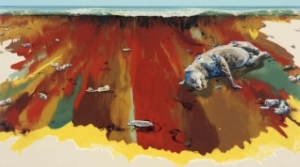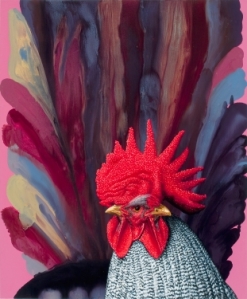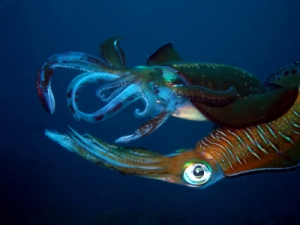I found this site originally from a class at UCSB, Interspecies Collaborations, “a collaborative research space for documenting the progress of art projects made together with non-human animals and for posting resources relevant to such endeavors.”

ANIMALS, PEOPLE AND THOSE IN BETWEEN
I found this site originally from a class at UCSB, Interspecies Collaborations, “a collaborative research space for documenting the progress of art projects made together with non-human animals and for posting resources relevant to such endeavors.”
I snagged this from The Atlantic, Andrew Solomon’s Daily Dish,
It’s a quote from Henry Beston’s The Outermost House:
“We need another and a wiser and perhaps a more mystical concept of animals. Remote from universal nature, and living by complicated artifice, man in civilization surveys the creature through the glass of his knowledge and sees thereby a feather magnified and the whole image in distortion. We patronize them for their incompleteness, for their tragic fate of having taken form so far below ourselves. And therein we err, and greatly err. For the animal shall not be measured by man. In a world older and more complete than ours they move finished and complete, gifted with extensions of the senses we have lost or never attained, living by voices we shall never hear. They are not brethren, they are not underlings; they are other nations, caught with ourselves in the net of life and time, fellow prisoners of the splendour and travail of the earth.”
There’s been much writing lately around removing the hierarchical imposition of humans and the rest of ’em. I’m 100% plus on this one. But referring to non-human animal species as “animal nations” is problematic. Not sure how I feel about creating statehood for any of us. There’s far too much overlap, hybridity, intertwingling for such discrete apportioning. And the more we think about our (constantly) renaturing world, the more stories like the ones below emerge, and can’t be considered “naturally” aberrant, or completely the product of human artifice:
My friend Abigail Simon found this one.
and this one is very strange… I love it when you “sigh,” birdie.
Granted these are animals in altered (mediated by humans, forced cohabitation) settings, I’m trying to do research on wild instances of interspecies cooperation/curiosity. There are plenty of examples of tolerance (watering holes, feeding grounds, lakes, rivers). But the line between coexistence and cooperation is interesting.
Alexis Rockman has a show of new paintings at Nyehaus Gallery in New York.


Bruce Sterling wrote that:
“Though he is known for the searing clarity of his paintings, there are things below the waterline that he does not paint.Years ago, the alligator made up his mind about these central issues in his oeuvre. He decided, as an act of deliberate will, to maintain his amphibious ambiguity. An ambiguity about the boundary of man and animal. An ambiguity about the borders of nature and artifice. Of art, of science…Human debris, sinking to the inky bottom of the alligator pond, a harvest too bitter even for the worms…Glassware, toxic vinyl, and shiny aluminum; a styrofoam soup in the Pacific, polar ice gone missing with no forwarding address, a food web blown to rotten lace, with gothic cobwebby holes of the vanished in the Sixth Great Extinction…A fantastic mulch of the natural and political. Yesterday’s brilliant inventions, more mortal even than their masters, become an ooze in the planet’s hidden waters, a toxic dust, the plaything of the whipping winds.Dripping mayhem covers the canvas: north, east, south and west, center, pole and periphery, forward and back in time. On any scale a monster might care to depict: glaciers, tornadoes, down the busily swarming bacteria, swapping their pirate cassettes of antibiotic resistance, like the music-tape pirates down at Saint Mark’s Place. New genes, plucked like snarled wire from the guts of a shattered piano, then kinked, knotted, plier-jammed into the tasty flesh of pigs, chickens and cows. Over-eager weeds break from concrete sidewalks bridging sullen, forgotten, still-dripping New York streams. “
These paintings need to be seen in person; their alternately pasty palette-smeared impasto and resin-wet gloss surfaces mess with your eyeballs, vascillating between vivid, convincing representation and distressed, formal, melting swaths of color.
The Humboldt squid has 36,000 teeth in total. Moves fast. Eats dirty. Is big. Gorgeous, graceful, and alien creature.
“The Humboldt squid is a voracious predator that will eat anything it can get its tentacles on.” – livescience.com

Creatures of a new mythology. Moving up and down the water columns. Ecosystem parasites. Opportunists. Formidable monsters. Predators. I say monsters, because with climate change the Humboldt squid “substantially expanded its perennial geographic range in the eastern North Pacific by invading the waters off central California. This sustained range expansion coincides with changes in climate-linked oceanographic conditions and a reduction in competing top predators. It is also coincident with a decline in the abundance of Pacific hake, the most important commercial groundfish species off western North America.” – National Academy of Sciences
The squid are expanding their range vertically, in terms of depth and horizontally in terms of range, and eating away their prey. They are competing for our food, having outlasted their competing predators and exhibiting robust resistance to changing conditions.
Monsters represent a threat to our safety and livelihoods. They are our wily and flexible competitors.

Charles Moore is founder of the Algalita Marine Research Foundation, one of the first to trawl the Garbage Patch. He captains the foundation’s research vessel, the Alguita, documenting the largest “landfills” of plastic waste that litter the oceans.
“A yachting competition across the Pacific led veteran seafarer Charles Moore to discover what some have since deemed the world’s largest “landfill” — actually a huge water-bound swath of floating plastic garbage the size of two Texases. Trapped in an enormous slow whirlpool called the Pacific Gyre, a mostly stagnant, plankton-rich seascape spun of massive competing air currents, this Great Pacific Garbage Patch in some places outweighs even the surface waters’ biomass six-to-one.”

When I was digging around for Paradoxical Sleep, I wanted to find out what happened after San Jose’s Guadalupe River, after the South Bay of Northern California. The whirling gyre of nasty pollution information literally culminated in this vortex: The North Pacific Garbage Patch, an area the size of Texas that’s a confluence of ocean currents, north of Hawaii. Maybe it’s twice the size of Texas: it’s an undulating swirling mass; it’s a soup of industrial and consumer plastics; some are plastic pellets from manufacturing, small enough to be mistaken for plankton and eaten by marine animals; lots are large enough to comprise a bounty in a net haul.